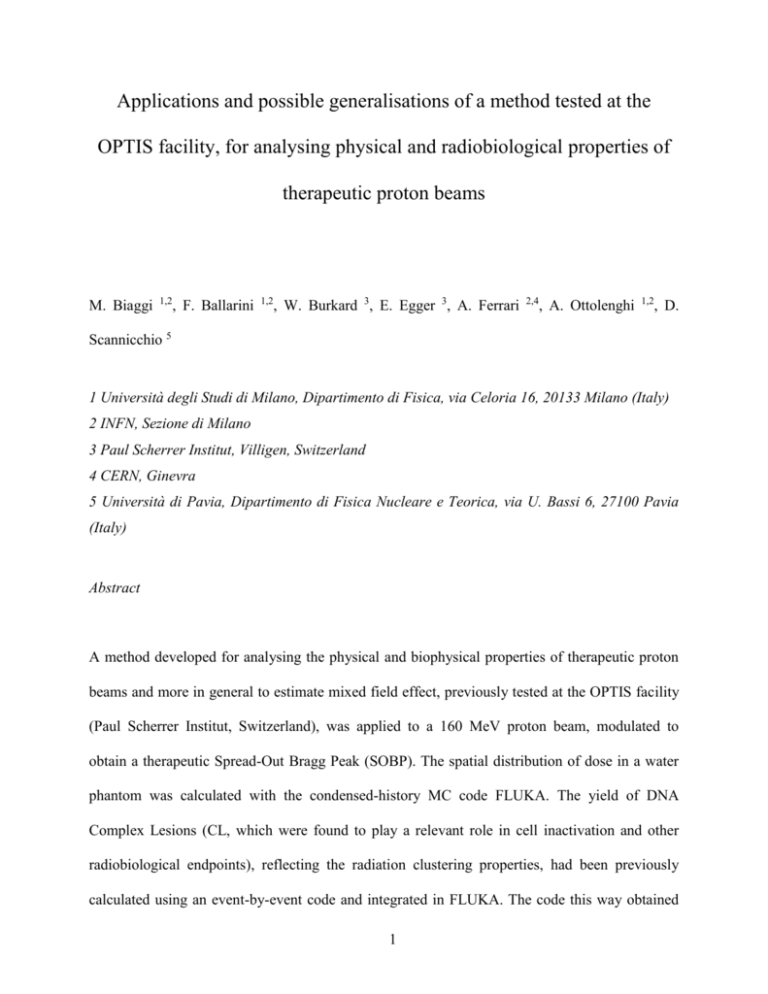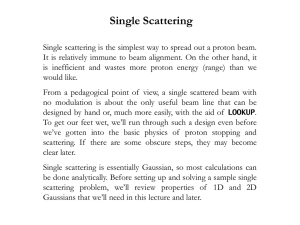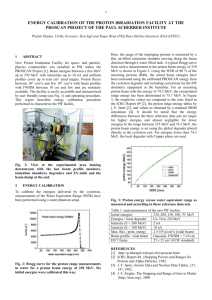A Monte Carlo code for a direct estimation of radiation risk
advertisement

Applications and possible generalisations of a method tested at the OPTIS facility, for analysing physical and radiobiological properties of therapeutic proton beams M. Biaggi 1,2 , F. Ballarini 1,2 , W. Burkard 3, E. Egger 3, A. Ferrari 2,4 , A. Ottolenghi 1,2 , D. Scannicchio 5 1 Università degli Studi di Milano, Dipartimento di Fisica, via Celoria 16, 20133 Milano (Italy) 2 INFN, Sezione di Milano 3 Paul Scherrer Institut, Villigen, Switzerland 4 CERN, Ginevra 5 Università di Pavia, Dipartimento di Fisica Nucleare e Teorica, via U. Bassi 6, 27100 Pavia (Italy) Abstract A method developed for analysing the physical and biophysical properties of therapeutic proton beams and more in general to estimate mixed field effect, previously tested at the OPTIS facility (Paul Scherrer Institut, Switzerland), was applied to a 160 MeV proton beam, modulated to obtain a therapeutic Spread-Out Bragg Peak (SOBP). The spatial distribution of dose in a water phantom was calculated with the condensed-history MC code FLUKA. The yield of DNA Complex Lesions (CL, which were found to play a relevant role in cell inactivation and other radiobiological endpoints), reflecting the radiation clustering properties, had been previously calculated using an event-by-event code and integrated in FLUKA. The code this way obtained 1 provides the spatial distribution of CL per cell, which can be regarded as a "biological dose". The contribution of the secondary hadrons to the biological dose was found to be much more relevant with respect to the case of the physical dose and therefore cannot be neglected. An RBE of 1.2 was found along the plateau and in most of the SOBP (due to secondary hadrons), with a sharp increase in the distal part (due to the presence of low energy protons). The "biological peak" resulted to be shifted towards larger depths with respect to the physical peak. The results are in good agreement with experimental data reported in the literature. KEY WORDS: Monte Carlo, mixed fields, proton therapy, RBE, Spread-Out Bragg Peak 2 1. Introduction Proton beams offer several potential advantages for the treatment of localised tumours, due to their ability to conform the dose distribution. To better optimise tumour treatments, a better understanding of the physical characteristics of the particle beams together with their biological effectiveness is highly desirable. In particular, the role of secondary hadrons (including neutrons) in determining 3D dose distributions needs to be evaluated at quantitative level [1]. Furthermore, it has to be taken into account that the energy deposition in matter is a stochastic process and a description in terms of dose, LET and RBE, which are average quantities not directly correlated with the induction of radiobiological damage, is not sufficient. Indeed, new reference parameters have to be identified, able to provide a direct relationship between track-structure features and radiobiological damage, thus allowing a quantitative evaluation of the radiation action at molecular and cell level. In a previous work [2] the yields of “Complex Lesions” (clustered DNA breaks that might play a relevant role in various biological endpoints, including cell inactivation [3]) obtained from an event-by-event track structure code (MOCA15 [4, 5]) were integrated in the code FLUKA [6], a condensed-history Monte Carlo code that simulates the transport of various hadron types, taking into account nuclear interactions. The physical characteristics and the effectiveness in Complex Lesion induction of a 150 MeV proton beam slowing down in water were analysed. The work led to the following conclusions: a) at high energies – before the Bragg peak – secondary hadrons play a relevant role giving rise to an increase in the biological effectiveness; b) the peak in the yield of Complex Lesions (“biological peak”) is more pronounced than the depth-dose Bragg peak; c) the biological peak is slightly shifted to a larger depth. This approach was tested with the therapeutic proton beam line of the OPTIS facility at the Paul Scherrer Institut (PSI) of Villigen, 3 Switzerland [7]. The OPTIS facility utilises a 72 MeV proton beam, which is particularly suitable to treat tumours of the ocular cavity, since the maximum range in tissue is 3.15 cm. A detailed description of the facility, the beam optics and the treatment procedure is reported in [8-10]. The physical and radiobiological characteristics of a fully-modulated beam of the OPTIS facility were analysed in deep detail by adopting an experimental and theoretical approach. In the work here presented the method was applied to the case of a 160 MeV modulated proton beam, which gives rise to the typical depth-dose distribution utilised for therapy, a plateau followed by a Spread Out Bragg Peak. 2. The method and its rationale FLUKA is a condensed-history Monte Carlo code that transports hadronic and electromagnetic particles over a wide energy range and in any material. It is a multi-purposed, multi-particle Monte Carlo code that can be applied in different fields. Attention is particularly focussed on following the various components of the hadronic and electromagnetic cascades. Therefore the characteristics of the FLUKA code at intermediate energies make it particularly reliable in treating radiotherapy problems. The FLUKA code has been purposely modified: a) to separately provide the contributions of the various beam components to the absorbed dose (primary protons, electrons with energy greater than 10 keV and secondary hadrons, including ions); b) to provide a 3D distribution of a “biological dose” in the case of mixed fields, taking into account the clustering properties of the different beam components of the slowing down beam. The latter was obtained by integrating in FLUKA the yield of Complex Lesions per Gray per cell previously calculated by using an event-by-event code (MOCA15) and a DNA geometrical model [11]. 4 To validate the method, comparisons have been carried out between simulations and measurements done at the therapy unit of the OPTIS facility. The geometry of the apparatus was faithfully reproduced, taking into account the beam characteristics at the entrance of the unit. The beam modulation at OPTIS is obtained by means of a passive beam-delivery method: 16 identical aluminium profiles (with thickness ranging from 0 to 1.5 cm) are mounted on a rotating wheel. The whole system was dynamically simulated. Details can be found in [7]. Ad hoc experiments were carried out to validate the simulations: the OPTIS apparatus was set up in order to obtain a completely Spread-Out Bragg Peak in a perspex phantom, the depth-dose distribution profile was measured before irradiation and the clonogenic survival of hamster fibroblast cells was measured at different depths. The input data introduced in the simulations were fixed a priori on the basis of the information directly provided by PSI. No free parameter was introduced and no a posteriori fit to experimental data was performed. The direct comparison of the simulation results with the measurements of physical dose distribution and experimental data on cell survival showed great agreement (for details see [7]). In figure 1 the calculated number of Complex Lesions per cell induced by the OPTIS beam is reported as a function of depth in perspex (upper curve); the yield of CL is compared with the yield obtained by assuming a constant effectiveness equal to that of X rays (lower curve). The biological peak shows a sharp increase in correspondence of the distal part of the completely Spread-Out Bragg Peak. Moreover, the biological peak is shifted to larger depths with respect to the physical one. With respect to the distribution of physical dose, the depth-distribution of biological damage is less homogeneous in the proximal and central part of the SOBP, due to an increase of the role of secondary hadrons in the case of the “biological dose”. The agreement between the theoretical predictions and the experimental data (RBE for V79 cell inactivation) permitted the validation of the biophysical model adopted and the evaluation of the role of the Complex Lesions. 5 In this work the method described above was applied to a 160 MeV modulated proton beam, using lucite for the modulation. The aim was to analyse the predictions of the model and the code with a beam modulation similar to that used in real treatments. The initial energy was 160 MeV (p/p=1% was assumed for the energy spread) and the beam width was 1 cm; a water phantom was used. The modulator wheel was simulated by adding weighted contributions of individual degraded Bragg peak curves. 11 geometry inputs were used, each corresponding to a different thickness of lucite (ranging from 0 to 3 cm). 3. Results In panel a of figure 2 the depth-dose curve in water obtained by adding the weighted contributions of individual degraded Bragg peak curves is reported. The dose deposited by each beam component is reported separately. The calculation showed that the secondary hadron component accounts for 6% of the total dose at the beginning of the plateau, 3% in most of the SOBP and disappears in correspondence of the distal part of the SOBP. In panel b of figure 2 the calculated relative number of Complex Lesions per cell as a function of depth in water induced by the 160 MeV beam is reported. For each component, the upper curve represents the yield of Complex Lesions per cell induced by the proton beam, whereas the lower curve represents the yield of Complex Lesions per cell that one would obtain by assuming a constant effectiveness equal to that of rays. Again, we observed a sharp increase in the distal part of the biological peak and, with respect to the physical peak, the role of secondary hadrons is more relevant in the case of the biological peak, reaching percentages of 20% at the beginning of the plateau and 15% in the SOBP. Also in this case, the secondary hadron component disappears in 6 correspondence of the distal part of the SOBP. As expected, the curve relative to the electrons component in the case of the Complex Lesions induced by the proton beam and the curve obtained by assuming a constant effectiveness equal to that of rays coincide, whereas for the primary proton component the curves coincide only along the plateau; in fact the primary proton component of the biological dose distribution increases dramatically with depth in passing from the proximal to the distal part of the SOBP. Moreover, as for the OPTIS beam, the biological peak is shifted toward larger depths with respect to the physical one. This aspect can be of great importance in proton therapy, especially in presence of critical organs just after the Bragg peak. In panel c of figure 2, a quantity that can be considered an approximation of the RBE is reported. In fact, it represents the ratio between the Complex Lesions per cell induced by the 160 MeV modulated proton beam at different depths in water and the Complex Lesions per cell that one would obtain by assuming the same dose induced by rays; if the biological effect can be assumed to be linear with dose (a reasonable approximation for low doses), this quantity coincides with RBE (the ratio between the doses of different radiation types needed to obtain the same effect). The value of the RBE was found to be roughly constant with depth ( 1.2) along the plateau and most of the SOBP, but showed a sharp increase in correspondence of the distal part. In therapeutic practice, a constant RBE value of 1.1 is currently used. The constant RBE value along the plateau and most of the SOBP is due to a decrease of the secondary hadron component with depth (see panel b of figure 2), balanced by an increase of the effectiveness of slowing-down primary protons. The sharp increase of RBE at the distal part, together with the shift of the biological peak, is due to the large presence of very low-energy (i.e. high LET) protons that dramatically increase the clustering properties of the beam, although the secondary hadron component goes virtually to zero. Similar experimental RBE behaviours as a function of depth 7 with a significant increase in the distal part of the SOBP are reported in literature (see for example [7, 12, 13]). 4. Conclusions and future developments From the simulations described in this work some basic conclusions can be drawn, together with some indications for more detailed studies: a) at higher energies (before the Bragg peak) there is a significant role of secondary hadrons that give rise to an increase of a factor 1.2 of the biological effectiveness, compared with rays or electrons; b) the biological SOBP shows a sharp increase in correspondence of the distal part of the peak due to the presence of low energy protons; c) the biological peak is shifted toward larger depths with respect to the physical peak; d) the yield of Complex Lesions can be considered a reliable parameter for describing the biophysical characteristics (including the stochastic aspects and the clustering properties) of mixed fields. The results of this work showed that the optimisation of treatment planning with proton beams should take into account variations in the biological effectiveness of the beam with depth. This is possible by developing Monte Carlo simulation codes able to reproduce the spatial distribution of biological effects, taking into account the clustering properties of the various beam components. This is today of great interest, since the use of Monte Carlo codes in tumour treatment planning is becoming feasible, at least for therapy with proton beams. The method presented in this paper will be extended and refined: the beam lines at OPTIS, at CPO (Centre de Protontherapie d’Orsay, France) and at CCO (Clatterbridge Centre for Oncology, UK) will be reproduced in detail and compared, in order to analyse different techniques and 8 apparatuses for the treatment of choroidal hemangioma and to understand possible differences in the treatment characteristics (e.g. normal tissue complications) arising from different centres. Acknowledgements This work was partially supported by the EU contract no. FIGH-CT1999-00005 ("Low dose risk models"). 9 REFERENCES 1. Laitano R, Rosetti M, Frisoni M. Effects of nuclear interactions on energy and stopping power in proton beam dosimetry. NIM A 1996: 376; 466-476. 2. Ferrari A, Merzagora M, Ottolenghi A. Analysis of a slowing down 150 MeV proton beam in water: physical characteristics and effectiveness in inducing DNA clustered damage. In: 6th workshop on heavy-charged particles in biology and medicine, Baveno (Italy), September 2930 and October 1 1997. Kraft G. and Langbein K. Eds. Darmstadt. GSI Report 1997; 97-109. 3. Ottolenghi A, Monforti F, Merzagora M. A Monte Carlo calculation of cell inactivation by light ions. Int J Radiat Biol 1997: 72; 505-513. 4. Paretzke HG. Radiation track structure theory. In: Kinetics of nonhomogeneous processes, Freeman GR. Eds. New York. Wiley, 1987: 89-170. 5. Ottolenghi A, Merzagora M, Paretzke HG. DNA complex lesions induced by protons and particles: track structure characteristics determining linear energy transfer and particle type dependence. Radiat Environ Biophys 1997: 36; 97-103. 6. Ferrari A, Sala P. Treating high energy showers. In: Use of MCNP in radiation protection and dosimetry, Bologna (Italy), May 13-16 1996. Gualdrini G. and Casalini L. Eds. Roma. ENEA 1998; 233-64. 7. Biaggi M, Ballarini F, Burkard W, Egger E, Ferrari A, Ottolenghi A. Physical and biophysical characteristics of a fully modulated 72 MeV therapeutic proton beam: model predictions and experimental data. NIM B 1999: 159; 89-100. 10 8. Markovits Ch. The OPTIS facility at PSI for the proton therapy of uveal melanomas: 9-years experience from the accelerator point of view. In: Hadrontherapy in Oncology. Amaldi U. and Larsson B. Eds. 1994; 462-470. 9. Markovits Ch, Jaccard S, Perret Ch. The proton beam facility OPTIS for the therapy of ocular tumours. In: Proceedings of the 12th international conference on cyclotrons and their applications. Martin B. and Ziegler K. Eds. Singapore. World Scientific 1991; 507-510. 10. Egger E, Zografos L, Perret C. In: Medical Radiology-Diagnostic imaging and radiation oncology, radiotherapy of intraocular and orbital tumours. Berlin. Springer 1993; 57-72. 11. Ottolenghi A, Merzagora M, Tallone L, Durante M, Paretzke HG, Wilson WE. The quality of DNA double-strand breaks: a Monte Carlo simulation of the end-structure of strand breaks produced by protons and alpha particles. Radiat Environ Biophys 1995: 34; 239-44. 12. Courdi A, Brassart N, Herault J, Chauvel P. The depth-dependent radiation response of human melanoma cells exposed to 65 MeV protons. Brit J Radiol 1994: 67; 800-804. 13. Wouters BG, Lam GKY, Oelfke K, Durand RE, Skarsgard LD. Measurements of relative biological effectiveness of the 70 MeV proton beam at TRIUMF using chinese Hamster V79 cells and the high-precision sorter assay. Rad Res 1996: 146; 159-170. 11 FIGURE CAPTIONS Fig. 1: calculated relative number of Complex Lesions (CL) per cell as a function of depth in perspex induced by the 72 MeV modulated proton beam of the OPTIS facility (upper curve). The lower curve represents the yield of Complex Lesions/cell that one would obtain by assuming a constant effectiveness equal to that of rays. Fig. 2: Panel a: depth-dose curve in water of a 160 MeV modulated proton beam simulated with the FLUKA code. The doses deposited by the various beam components are reported separately. Panel b: calculated relative number of CL per cell as a function of depth in water induced by the 160 MeV modulated proton beam. For each component, the upper curve represents the yield of CL per cell induced by the various beam components, as reported in panel a, whereas the lower curve represents the yield of CL per cell that one would obtain assuming a constant effectiveness equal to that of rays. Panel c: ratio between the DNA Complex Lesions per cell induced by the 160 MeV modulated proton beam at different depths in water and the Complex Lesions per cell that one would obtain assuming the same dose induced by rays. See text for details. 12








